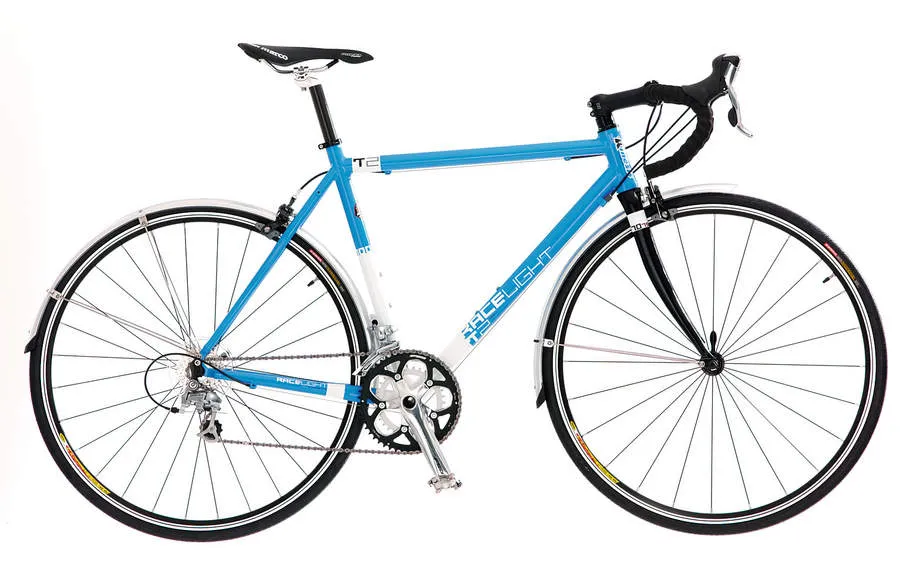Winter training used to be the main focus of Kinesis's range of svelte aluminium Racelight bikes, but these days they're pitched as audax and all-round road bikes too.
The T2 is at its best on shorter rides where you want to push the pace – a 15-mile commute, maybe, or an hour's training ride. With its long reach and aluminium fork, it wouldn't be our first choice for distance rides, and although there's a set of rack/mudguard eyelets, you'd lose the benefit of its low weight if you were to fit luggage.
- Frame: Steep angles and low weight make it feel more like a race bike, yet clearance for mudguards hasn’t been compromised. An aluminium fork is an odd choice (7/10)
- Handling: Stiff and light, which will keep the inner racer happy when commuting or training, but we’re dubious about audax or sportive rides on that unforgiving fork (7/10)
- Equipment: Shimano Tiagra performs well. We’d add safety fixings to the front mudguard stays (7/10)
- Wheels: Rather average training tyres have been fitted to wheels built for low-weight rather than dependability. This bike really deserves some Michelin Krylions (7/10)
The Racelight lives up to its name, weighing in at 9.49kg (20.9lb, without pedals). The frame is 7005-series aluminium tubes, butted at both ends. Bigger tube diameters resist flexing, which is important as aluminium lacks steel’s springiness. If allowed to flex like steel, aluminium would eventually crack. The chainstays, in particular, are very beefy and very stiff – something that a big rider powering along out of the saddle will appreciate.
It’s unusual to see an aluminium rather than carbon fibre or steel fork. As noted, there’s little resilience in aluminium. That doesn’t matter in a triangulated structure like the frame, where there’s negligible vertical compliance anyway, but a fork with a bit of ‘give’ can take the edge off road buzz and bumps. On shorter rides you’re not aware of any extra harshness, though it could well become an issue if you’re buying the Racelight for audax rides rather than training rides or the sprint to work. (A carbon-forked version of this bike is available for an extra £70.)
Even though it’s race bike light, the Racelight has clearance for mudguards and bigger tyres than the 23mm ones fitted, and there’s no toe overlap. There’s only one set of eyelets at the rear dropouts, so if you add a rack it’ll have to share the mudguard’s. The front mudguard is of greater concern: as there’s no breakaway clip, if anything does get jammed under it you’ll very likely be eating tarmac.
The Racelight’s reach is fairly long. This is mostly down to the 110mm stem, so is easily changed if you want to bring the bar up and back for more relaxed riding. As it stands, the sporty stretch to the bar and the bike’s low weight overall reward a more athletic riding style. It’s great for take-no-prisoners training rides or reeling in rivals on your commute. It’s not a straight trade-off of comfort for speed either: the contact points, including an oversized bar, are good, and there’s a carbon seatpost to take the sting out of the more rigid rear end.
Shifters and mechs are Shimano Tiagra, while the chainset is an FSA Gossamer compact. Tiagra shifters share the washing-line cable routing of Sora but shifting to a smaller sprocket or chainring is via paddle shifters behind the brake lever rather than Sora’s thumb button. You get more shifting ‘feel’, and it helps that the short-cage rear mech gives a bit more snap to each shift. The FSA chainset saves some weight compared to a Sora one, but is functionally indistinguishable. A 12-25T cassette is fitted; a 27T sprocket would have been welcome for easier climbing.
The wheels are racy for an all-rounder. This isn’t because of the components – Mavic CXP22 rims are fine but nothing special, and the hubs are unbranded – but because of the spoking: 24 at the front and 28 at the back. Compared to 32-spoke wheels, shedding spokes saves a little bit of weight at the risk of a weaker wheel. That’s a risk worth taking on a Sunday best bike where weight and speed matter; not so much on a daily-grind training bike or a reliability-first audax bike. Kenda Kontenders, meanwhile, are bread and butter training tyres: we’d upgrade to something faster and tougher fairly soon.

